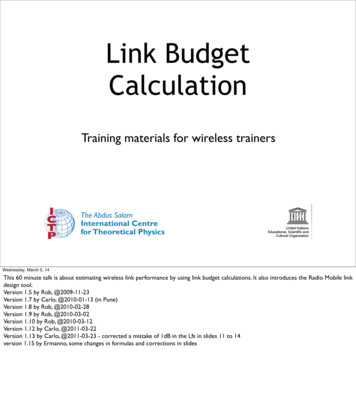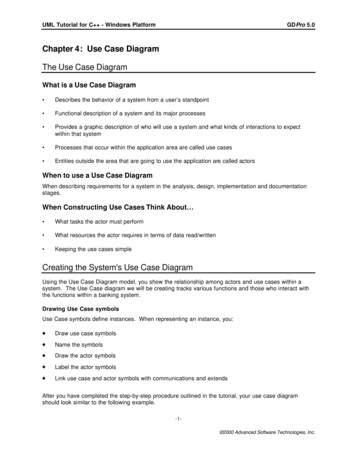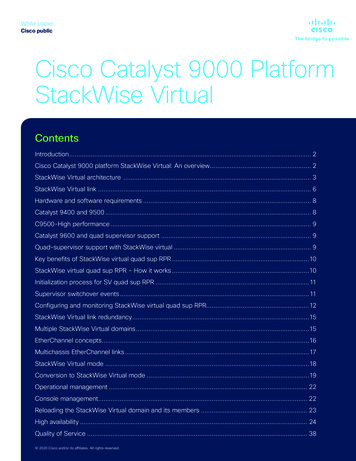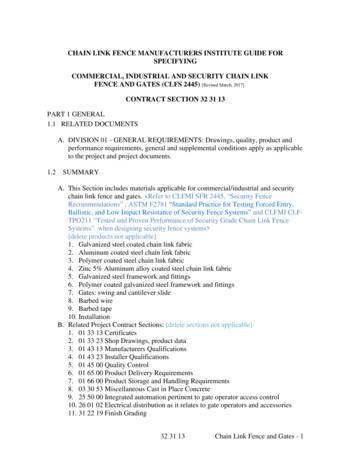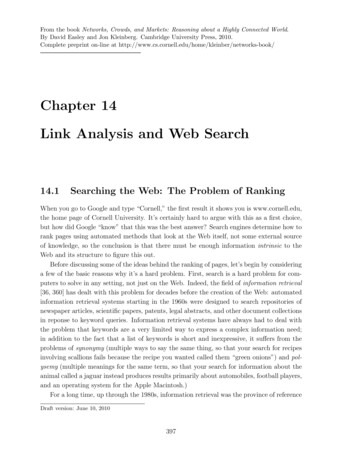
Transcription
From the book Networks, Crowds, and Markets: Reasoning about a Highly Connected World.By David Easley and Jon Kleinberg. Cambridge University Press, 2010.Complete preprint on-line at ook/Chapter 14Link Analysis and Web Search14.1Searching the Web: The Problem of RankingWhen you go to Google and type “Cornell,” the first result it shows you is www.cornell.edu,the home page of Cornell University. It’s certainly hard to argue with this as a first choice,but how did Google “know” that this was the best answer? Search engines determine how torank pages using automated methods that look at the Web itself, not some external sourceof knowledge, so the conclusion is that there must be enough information intrinsic to theWeb and its structure to figure this out.Before discussing some of the ideas behind the ranking of pages, let’s begin by consideringa few of the basic reasons why it’s a hard problem. First, search is a hard problem for computers to solve in any setting, not just on the Web. Indeed, the field of information retrieval[36, 360] has dealt with this problem for decades before the creation of the Web: automatedinformation retrieval systems starting in the 1960s were designed to search repositories ofnewspaper articles, scientific papers, patents, legal abstracts, and other document collectionsin reponse to keyword queries. Information retrieval systems have always had to deal withthe problem that keywords are a very limited way to express a complex information need;in addition to the fact that a list of keywords is short and inexpressive, it suffers from theproblems of synonymy (multiple ways to say the same thing, so that your search for recipesinvolving scallions fails because the recipe you wanted called them “green onions”) and polysemy (multiple meanings for the same term, so that your search for information about theanimal called a jaguar instead produces results primarily about automobiles, football players,and an operating system for the Apple Macintosh.)For a long time, up through the 1980s, information retrieval was the province of referenceDraft version: June 10, 2010397
398CHAPTER 14. LINK ANALYSIS AND WEB SEARCHlibrarians, patent attorneys, and other people whose jobs consisted of searching collections ofdocuments; such people were trained in how to formulate effective queries, and the documentsthey were searching tended to be written by professionals, using a controlled style andvocabulary. With the arrival of the Web, where everyone is an author and everyone is asearcher, the problems surrounding information retrieval exploded in scale and complexity.To begin with, the diversity in authoring styles makes it much harder to rank documentsaccording to a common criterion: on a single topic, one can easily find pages written byexperts, novices, children, conspiracy theorists — and not necessarily be able to tell which iswhich. Once upon a time, the fact that someone had the money and resources to produce aprofessional-looking, typeset, bound document meant that they were very likely (even if notalways) someone who could be taken seriously. Today, anyone can create a Web page withhigh production values.There is a correspondingly rich diversity in the set of people issuing queries, and theproblem of multiple meanings becomes particularly severe. For example, when someoneissues the single-word query “Cornell,” a search engine doesn’t have very much to go on.Did the searcher want information about the university? The university’s hockey team? TheLab of Ornithology run by the university? Cornell College in Iowa? The Nobel-Prize-winningphysicist Eric Cornell? The same ranking of search results can’t be right for everyone.These represent problems that were also present in traditional information retrieval systems, just taken to new extremes. But the Web also introduces new kinds of problems. Oneis the dynamic and constantly-changing nature of Web content. On September 11, 2001,many people ran to Google and typed “World Trade Center.” But there was a mismatchbetween what people thought they could get from Google and what they really got: sinceGoogle at the time was built on a model in which it periodically collected Web pages andindexed them, the results were all based on pages that were gathered days or weeks earlier,and so the top results were all descriptive pages about the building itself, not about whathad occurred that morning. In response to such events, Google and the other main searchengines built specialized “News Search” features, which collect articles more or less continuously from a relatively fixed number of news sources, so as to be able to answer queriesabout news stories minutes after they appear. Even today, such news search features areonly partly integrated into the core parts of the search engine interface, and emerging Websites such as Twitter continue to fill in the spaces that exist between static content andreal-time awareness.More fundamental still, and at the heart of many of these issues, is the fact that theWeb has shifted much of the information retrieval question from a problem of scarcity to aproblem of abundance. The prototypical applications of information retrieval in the pre-Webera had a “needle-in-a-haystack” flavor — for example, an intellectual-property attorneymight express the information need, “find me any patents that have dealt with the design
14.2. LINK ANALYSIS USING HUBS AND AUTHORITIES399of elevator speed regulators based on fuzzy-logic controllers.” Such issues still arise today,but the hard part for most Web searches carried out by the general public is in a sense theopposite: to filter, from among an enormous number of relevant documents, the few thatare most important. In other words, a search engine has no problem finding and indexingliterally millions of documents that are genuinely relevant to the one-word query “Cornell”;the problem is that the human being performing the search is going to want to look at onlya few of these. Which few should the search engine recommend?An understanding of the network structure of Web pages will be crucial for addressingthese questions, as we now discuss.14.2Link Analysis using Hubs and AuthoritiesSo we’re back to our question from the beginning of the chapter: in response to the one-wordquery “Cornell,” what are the clues that suggest Cornell’s home page, www.cornell.edu, is agood answer?Voting by In-Links. In fact, there is a natural way to address this, provided we startfrom the right perspective. This perspective is to note that there is not really any way touse features purely internal to the page www.cornell.edu to solve this problem: it does notuse the word “Cornell” more frequently or more prominently than thousands of other pages.and so there is nothing on the page itself that makes it stand out. Rather, it stands outbecause of features on other Web pages: when a page is relevant to the query “Cornell,”very often www.cornell.edu is among the pages it links to.This is the first part of the argument that links are essential to ranking: that we can usethem to assess the authority of a page on a topic, through the implicit endorsements thatother pages on the topic confer through their links to it. Of course, each individual linkmay have many possible meanings: it may be off-topic; it may convey criticism rather thanendorsement; it may be a paid advertisement. It is hard for search engines to automaticallyassess the intent of each link. But we hope that in aggregate, if a page receives many linksfrom other relevant pages, then it is receiving a kind of collective endorsement.In the case of the query “Cornell,” we could operationalize this by first collecting a largesample of pages that are relevant to the query — as determined by a classical, text-only,information retrieval approach. We could then let pages in this sample “vote” through theirlinks: which page on the Web receives the greatest number of in-links from pages that arerelevant to Cornell? Even this simple measure of link-counting works quite well for queriessuch as “Cornell,” where, ultimately, there is a single page that most people agree should beranked first.
400CHAPTER 14. LINK ANALYSIS AND WEB SEARCHSJ MercNewsWall St.JournalNew YorkTimesUSA TodayFacebookYahoo!Amazon2 votes2 votes4 votes3 votes1 vote3 votes3 votesFigure 14.1: Counting in-links to pages for the query “newspapers.”A List-Finding Technique. It’s possible to make deeper use of the network structurethan just counting in-links, and this brings us to the second part of the argument that linksare essential. Consider, as a typical example, the one-word query “newspapers.” Unlikethe query “Cornell,” there is not necessarily a single, intuitively “best” answer here; thereare a number of prominent newspapers on the Web, and an ideal answer would consist of alist of the most prominent among them. With the query “Cornell,” we discussed collectinga sample of pages relevant to the query and then let them vote using their links. Whathappens if we try this for the query “newspapers”?What you will typically observe, if you try this experiment, is that you get high scores for amix of prominent newspapers (i.e. the results you’d want) along with pages that are going toreceive a lot of in-links no matter what the query is — pages like Yahoo!, Facebook, Amazon,and others. In other words, to make up a very simple hyperlink structure for purposes of
14.2. LINK ANALYSIS USING HUBS AND AUTHORITIES401SJ MercNews2 votes8Wall St.Journal117New YorkTimes2 votes4 votes3656USA Today3 votes3Facebook3Yahoo!Amazon1 vote3 votes3 votesFigure 14.2: Finding good lists for the query “newspapers”: each page’s value as a list iswritten as a number inside it.this example, we’d see something like Figure 14.1: the unlabeled circles represent our sampleof pages relevant to the query “newspapers,” and among the four pages receiving the mostvotes from them, two are newspapers (New York Times and USA Today) and two are not(Yahoo! and Amazon). This example is designed to be small enough to try by hand; ina real setting, of course there would be many plausible newspaper pages and many moreoff-topic pages.But votes are only a very simple kind of measure that we can get from the link structure— there is much more to be discovered if we look more closely. To try getting more, weask a different question. In addition to the newspapers themselves, there is another kind ofuseful answer to our query: pages that compile lists of resources relevant to the topic. Suchpages exist for most broad enough queries: for “newspapers,” they would correspond to lists
402CHAPTER 14. LINK ANALYSIS AND WEB SEARCHSJ MercNewsnew score: 198Wall St.Journal117New YorkTimesnew score: 19new score: 313656USA Todaynew score: 243Facebook3Yahoo!Amazonnew score: 5new score: 15new score: 12Figure 14.3: Re-weighting votes for the query “newspapers”: each of the labeled page’s newscore is equal to the sum of the values of all lists that point to it.of links to on-line newspapers; for “Cornell,” one can find many alumni who maintain pageswith links to the University, its hockey team, its Medical School, its Art Museum, and soforth. If we could find good list pages for newspapers, we would have another approach tothe problem of finding the newspapers themselves.In fact, the example in Figure 14.1 suggests a useful technique for finding good lists. Wenotice that among the pages casting votes, a few of them in fact voted for many of the pagesthat received a lot of votes. It would be natural, therefore, to suspect that these pages havesome sense where the good answers are, and to score them highly as lists. Concretely, wecould say that a page’s value as a list is equal to the sum of the votes received by all pagesthat it voted for. Figure 14.2 shows the result of applying this rule to the pages casting votesin our example.
14.2. LINK ANALYSIS USING HUBS AND AUTHORITIES403The Principle of Repeated Improvement. If we believe that pages scoring well as listsactually have a better sense for where the good results are, then we should weight their votesmore heavily. So, in particular, we could tabulate the votes again, but this time giving eachpage’s vote a weight equal to its value as a list. Figure 14.3 shows what happens when wedo this on our example: now the other newspapers have surpassed the initially high-scoringYahoo! and Amazon, because these other newspapers were endorsed by pages that wereestimated to be good lists.In fact, you can recognize the intuition behind this re-weighting of votes in the way weevaluate endorsements in our everyday lives. Suppose you move to a new town and hearrestaurant recommendations from a lot of people. After discovering that certain restaurantsget mentioned by a lot of people, you realize that certain people in fact had mentioned mostof these highly-recommended restaurants when you asked them. These people play the roleof the high-value lists on the Web, and it’s only natural to go back and take more seriouslythe more obscure restaurants that they recommended, since you now particularly trust theirjudgment. This last step is exactly what we are doing in re-weighting the votes for Webpages.The final part of the argument for link analysis is then the following: Why stop here? Ifwe have better votes on the right-hand-side of the figure, we can use these to get still morerefined values for the quality of the lists on the left-hand-side of the figure. And with morerefined estimates for the high-value lists, we can re-weight the votes that we apply to theright-hand-side once again. The process can go back and forth forever: it can be viewedas a Principle of Repeated Improvement, in which each refinement to one side of the figureenables a further refinement to the other.Hubs and Authorities. This suggests a ranking procedure that we can try to makeprecise, as follows [247]. First, we’ll call the kinds of pages we were originally seeking — theprominent, highly endorsed answers to the queries — the authorities for the query. We’ll callthe high-value lists the hubs for the query. Now, for each page p, we’re trying to estimateits value as a potential authority and as a potential hub, and so we assign it two numericalscores: auth(p) and hub(p). Each of these starts out with a value equal to 1, indicating thatwe’re initially agnostic as to which is the best in either of these categories.Now, voting – in which we use the quality of the hubs to refine our estimates for thequality of the authorities – is simply the following:Authority Update Rule: For each page p, update auth(p) to be the sum of thehub scores of all pages that point to it.On the other hand, the list-finding technique – in which we use the quality of the authoritiesto refine our estimates for the quality of the hubs, is the following:
404CHAPTER 14. LINK ANALYSIS AND WEB SEARCHSJ MercNewsnormalized .1528Wall St.Journal117New YorkTimesnormalized .152normalized .2483656USA Todaynormalized .1923Facebook3Yahoo!Amazonnormalized .040normalized .120normalized .096Figure 14.4: Re-weighting votes after normalizing for the query “newspapers.”Hub Update Rule: For each page p, update hub(p) to be the sum of the authorityscores of all pages that it points to.Notice how a single application of the Authority Update Rule (starting from a setting inwhich all scores are initially 1) is simply the original casting of votes by in-links. A singleapplication of the Authority Update Rule followed by a single application the Hub UpdateRule produces the results of the original list-finding technique. In general, the Principle ofRepeated Improvement says that to obtain better estimates, we should simply apply theserules in alternating fashion, as follows. We start with all hub scores and all authority scores equal to 1. We choose a number of steps k.
14.2. LINK ANALYSIS USING HUBS AND AUTHORITIES405SJ MercNewslimit .199.249Wall St.Journallimit .199.321.181New YorkTimeslimit .304.015.018.123.088USA Todaylimit .205.003Facebook.003Yahoo!Amazonlimit .043.limit .042.limit .008.Figure 14.5: Limiting hub and authority values for the query “newspapers.” We then perform a sequence of k hub-authority updates. Each update works as follows:– First apply the Authority Update Rule to the current set of scores.– Then apply the Hub Update Rule to the resulting set of scores. At the end, the hub and authority scores may involve numbers that are very large. Butwe only care about their relative sizes, so we can normalize to make them smaller: wedivide down each authority score by the sum of all authority scores, and divide downeach hub score by the sum of all hub scores. (For example, Figure 14.4 shows the resultof normalizing the authority scores that we determined in Figure 14.3.)What happens if we do this for larger and larger values of k? It turns out that thenormalized values actually converge to limits as k goes to infinity: in other words, the
406CHAPTER 14. LINK ANALYSIS AND WEB SEARCHresults stabilize so that continued improvement leads to smaller and smaller changes in thevalues we observe. We won’t prove this right now, but we provide a proof in Section 14.6 atthe end of this chapter. Moreover, the analysis in that section shows that something evendeeper is going on: except in a few rare cases (characterized by a certain kind of degenerateproperty of the link structure), we reach the same limiting values no matter what we chooseas the initial hub and authority values, provided only that all of them are positive. In otherwords, the limiting hub and authority values are a property purely of the link structure,not of the initial estimates we use to start the process of computing them. (For the record,the limiting values for our “newspapers” example are shown, to three decimal places, inFigure 14.5.)Ultimately, what these limiting values correspond to is a kind of equilibrium: their relativesizes remain unchanged if we apply the Authority Update Rule or the Hub Update Rule. Assuch, they reflect the balance between hubs and authorities that provided the initial intuitionfor them: your authority score is proportional to the hub scores of the pages that point toyou, and your hub score is proportional to the authority scores of the pages you point to.14.3PageRankThe intuition behind hubs and authorities is based on the idea that pages play multipleroles in the network, and in particular that pages can play a powerful endorsement rolewithout themselves being heavily endorsed. For queries with a commercial aspect — suchas our query for newspapers in the previous section, or searches for particular products topurchase, or more generally searches that are designed to yield corporate pages of any type— there is a natural basis for this intuition. Competing firms will not link to each other,except in unusual circumstances, and so they can’t be viewed as directly endorsing eachother; rather, the only way to conceptually pull them together is through a set of hub pagesthat link to all of them at once.In other settings on the Web, however, endorsement is best viewed as passing directlyfrom one prominent page to another — in other words, a page is important if it is citedby other important pages. This is often the dominant mode of endorsement, for example,among academic or governmental pages, among bloggers, or among personal pages moregenerally. It is also the dominant mode in the scientific literature. And it is this mode ofendorsement that forms the basis for the PageRank measure of importance [79].As with hubs and authorities, the intuition behind PageRank starts with simple votingbased on in-links, and refines it using the Principle of Repeated Improvement. In particular,the Principle is applied here by having nodes repeatedly pass endorsements across theirout-going links, with the weight of a node’s endorsement based on the current estimate ofits PageRank: nodes that are currently viewed as more important get to make stronger
14.3. PAGERANK407ABDCEFGHFigure 14.6: A collection of eight pages: A has the largest PageRank, followed by B and C(which collect endorsements from A).endorsements.The basic definition of PageRank. Intuitively, we can think of PageRank as a kind of“fluid” that circulates through the network, passing from node to node across edges, andpooling at the nodes that are the most important. Specifically, PageRank is computed asfollows. In a network with n nodes, we assign all nodes the same initial PageRank, set to be1/n. We choose a number of steps k. We then perform a sequence of k updates to the PageRank values, using the followingrule for each update:Basic PageRank Update Rule: Each page divides its current PageRank equallyacross its out-going links, and passes these equal shares to the pages it pointsto. (If a page has no out-going links, it passes all its current PageRank toitself.) Each page updates its new PageRank to be the sum of the shares itreceives.
408CHAPTER 14. LINK ANALYSIS AND WEB re 14.7: Equilibrium PageRank values for the network of eight Web pages from Figure 14.6.Notice that the total PageRank in the network will remain constant as we apply thesesteps: since each page takes its PageRank, divides it up, and passes it along links, PageRankis never created nor destroyed, just moved around from one node to another. As a result,we don’t need to do any normalizing of the numbers to prevent them from growing, the waywe had to with hub and authority scores.As an example, let’s consider how this computation works on the collection of 8 Webpages in Figure 14.6. All pages start out with a PageRank of 1/8, and their PageRankvalues after the first two updates are given by the following 1/32F1/161/32G1/161/32H1/81/16For example, A gets a PageRank of 1/2 after the first update because it gets all of F ’s,G’s, and H’s PageRank, and half each of D’s and E’s. On the other hand, B and C eachget half of A’s PageRank, so they only get 1/16 each in the first step. But once A acquiresa lot of PageRank, B and C benefit in the next step. This is in keeping with the principle ofrepeated improvement: after the first update causes us to estimate that A is an importantpage, we weigh its endorsement more highly in the next update.
14.3. PAGERANK409Equilibrium Values of PageRank. As with hub-authority computations, one can provethat except in certain degenerate special cases the PageRank values of all nodes converge tolimiting values as the number of update steps k goes to infinity.Because PageRank is conserved throughout the computation — with the total PageRankin the network equal to one — the limit of the process has a simple interpretation. We canthink of the limiting PageRank values, one value for each node, as exhibiting the followingkind of equilibrium: if we take the limiting PageRank values and apply one step of the BasicPageRank Update Rule, then the values at every node remain the same. In other words,the limiting PageRank values regenerate themselves exactly when they are updated. Thisdescription gives a simple way to check whether an assignment of numbers to a set of Webpages forms such an equilibrium set of PageRank values: we check that they sum to 1, andwe check that when we apply the Basic PageRank Update Rule, we get the same valuesback.For example, on the network of Web pages from Figure 14.6, we can check that thevalues shown in Figure 14.7 have the desired equilibrium property — assigning a PageRankof 4/13 to page A, 2/13 to each of B and C, and 1/13 to the five other pages achieves thisequilibrium.Now, depending on the network structure, the set of limiting values may not be theonly ones that exhibit this kind of equilibrium. However, one can show that if the networkis strongly connected — that is, each node can reach each other node by a directed path,following the definition from Chapter 13 — then there is a unique set of equilibrium values,and so whenever the limiting PageRank values exist, they are the only values that satisfythis equilibrium.Scaling the definition of PageRank. There is a difficulty with the basic definitionof PageRank, however: in many networks, the “wrong” nodes can end up with all thePageRank. Fortunately, there is a simple and natural way to fix this problem. yielding theactual definition of PageRank that is used in practice. Let’s first describe the problem andthen its solution.To trigger the problem, suppose we take the network in Figure 14.6 and make a smallchange, so that F and G now point to each other rather than pointing to A. The result isshown in Figure 14.8. Clearly this ought to weaken A somewhat, but in fact a much moreextreme thing happens: PageRank that flows from C to F and G can never circulate backinto the rest of the network, and so the links out of C function as a kind of “slow leak” thateventually causes all the PageRank to end up at F and G. We can indeed check that byrepeatedly running the Basic PageRank Update Rule, we converge to PageRank values of1/2 for each of F and G, and 0 for all other nodes.This is clearly not what we wanted, but it’s an inevitable consequence of the definition.
410CHAPTER 14. LINK ANALYSIS AND WEB SEARCHABDCEFGHFigure 14.8: The same collection of eight pages, but F and G have changed their links topoint to each other instead of to A. Without a smoothing effect, all the PageRank would goto F and G.And it becomes a problem in almost any real network to which PageRank is applied: aslong as there are small sets of nodes that can be reached from the rest of the graph, buthave no paths back, then PageRank will build up there.1 Fortunately, there is a simple andnatural way to modify the definition of PageRank to get around this problem, and it followsfrom the “fluid” intuition for PageRank. Specifically, if we think about the (admittedlysimplistic) question of why all the water on earth doesn’t inexorably run downhill and resideexclusively at the lowest points, it’s because there’s a counter-balancing process at work:water also evaporates and gets rained back down at higher elevations.We can use this idea here. We pick a scaling factor s that should be strictly between 0and 1. We then replace the Basic PageRank Update Rule with the following:Scaled PageRank Update Rule: First apply the Basic PageRank Update Rule.Then scale down all PageRank values by a factor of s. This means that the totalPageRank in the network has shrunk from 1 to s. We divide the residual 1 sunits of PageRank equally over all nodes, giving (1 s)/n to each.If we think back to the bow-tie structure of the Web from Chapter 13, there is a way to describe theproblem in those terms as well: there are many “slow leaks” out of the giant SCC, and so in the limit, allnodes in the giant SCC will get PageRank values of 0; instead, all the PageRank will end up in the set OUTof downstream nodes.1
14.3. PAGERANK411This rule also preserves the total PageRank in the network, since it is just based on redistribution according to a different “water cycle” that evaporates 1 s units of PageRank ineach step and rains it down uniformly across all nodes.The Limit of the Scaled PageRank Update Rule. One can show that repeated application of the Scaled PageRank Update Rule converges to a set of limiting PageRank valuesas the number of updates k goes to infinity. Moreover, for any network, these limiting valuesform the unique equilibrium for the Scaled PageRank Update Rule: they are the unique setof values that remain unchanged under the application of this update rule. Notice, of course,that these values depend on our choice of the scaling factor s: we should really think of therebeing a different update rule for each possible value of s.This is the version of PageRank that is used in practice, with a scaling factor s that isusually chosen to be between 0.8 and 0.9.2 The use of the scaling factor also turns out tomake the PageRank measure less sensitive to the addition or deletion of small numbers ofnodes or links [268, 422].Random walks: An equivalent definition of PageRank. To conclude our discussionin this section, we now describe an equivalent formulation of PageRank that looks quitedifferent on the surface, but in fact leads to exactly the same definition.It works as follows. Consider someone who is randomly browsing a network of Web pages,such as the one in Figure 14.6. They start by choosing a page at random, picking each pagewith equal probability. They then follow links for a sequence of k steps: in each step, theypick a random out-going link from their current page, and follow it to where it leads. (If theircurrent page has no out-going links, they just stay where they are.) Such an exploration ofnodes performed by randomly following links is called a random walk on the network. Weshould stress that this is not meant to be an accurate model of an actual person exploringthe Web; rather, it is a thought experiment that leads to a particular definition.In Section 14.6, we analyze this random walk and show the following fact:Claim: The probability of being at a page X after k steps of this random walk isprecisely the PageRank of X after k applications of the Basic PageRank UpdateRule.As an aside about our earlier motivating example, one can check that using a value of s in this rangedoesn’t completely fix the problem with Figure 14.8: nodes F and G still get most (though no longer all)of the PageRank under the scaled update rule with such values of s. The problem is that an eight-nodeexample is simply too small for the redistribution of the PageRank to truly offset the problem of a slow leakinto a dead-end region of the network: on only eight nodes, a “slow leak” isn’t actually so slow. However,on large networks such as are used in real applications, the r
USA Today Yahoo! Amazon Facebook 2 votes 4 votes 3 votes 1 vote 3 votes 3 votes SJ Merc News 2 votes Figure 14.1: Counting in-links to pages for the query “newspapers.” A List-Finding Technique. It’s possible to make deeper use of the network structure than just counting in-links, and this brings us to

